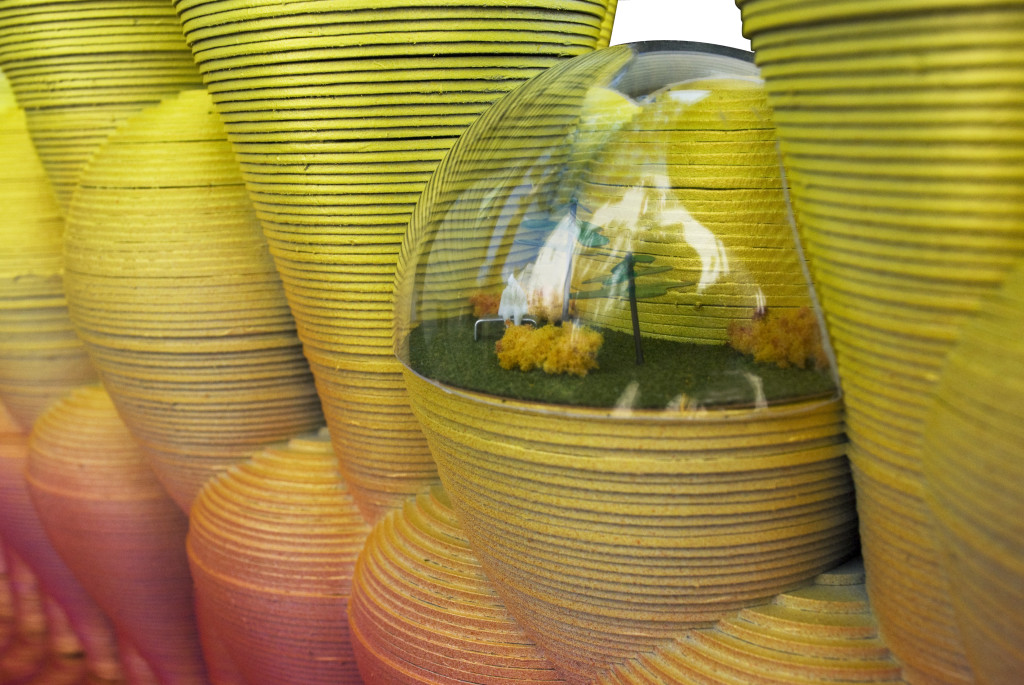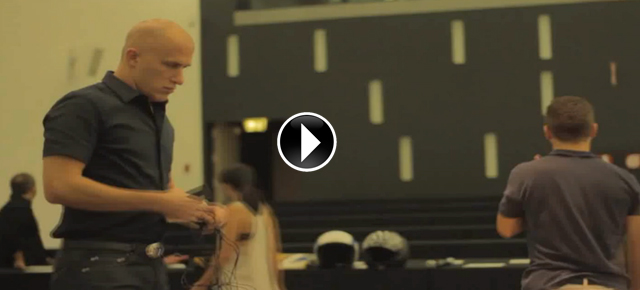Maristella Casciato Interview by Alexander McCargar
It is a challenge putting on an architectural exhibition for the public with the holdings of a single museum. Then try curating it in a Zaha Hadid building with the backdrop of the city of Rome. The current exhibition, Modelli, at the MAXXI, however, holds up to the challenge and is the first show in Rome and perhaps Italy devoted to architectural models.
An interview with curator Maristella Casciato helps to shed light on some of the considerations, topics and curatorial goals of the exhibit.
——————
As the MAXXI continues to evolve in its new home, an important objective is to build up its architectural collection. The Modelli Exhibition needed to showcase this collection and point to its further expansion. For the show, archives were collected, many existing models restored, and some younger architects were asked for models. Maristella explains that through this procedure, the museum aims to build “a culture of [contemporary] architecture within the city”. A main challenge was presenting the collection coherently. Some archives contain hundreds of models, some only one or two. The museum’s collection has been formed in an incongruous way. “Models are a part of the collection,” Maristella explains, “but they come into the collection in a very different way than a drawing or a project. Even when they were part of an archive, that was either acquired or donated to the MAXXI, the role of the model had already been very different. Some architects prefer to give their collection and not to offer or donate the models. The three-dimensional item within a project plays a very different role than the drawings. Sometimes you also have a different affection for the model because it represents a certain moment within the design process. Sometimes people who were in charge of making the model have their own affection or require to have the models as part of their own memories and personal collection…The exhibition is more than just opening the storage and extracting; it is very much a curatorial work.” While it was crucial to examine the role of the model within a certain architect’s oeuvre, it also came down to a show about the extents of and relationships within the museum’s own collection.
On the first floor, in the main hall of the exhibition, a large model of the nearby Foro Italico greets the visitor. This model, commissioned a few years ago by the MAXXI, is for the first time shown in the MAXXI space. Displayed in a previous exhibition at the Galeria del’Arte Moderna, many people never knew it was commissioned for the MAXXI collection.
In the large hall the massive lift used for transporting art has been left open, extending the length of the gallery and acting to create what Maristella describes as a “landscape and geography of models”, giving the viewer “the idea of a gaze immediately”. In this way, the dynamism of Hadid’s building is captured and utilized. This expansive, slightly curving geography of models further reacts to the museum’s architecture. A tall model, the Peugeot tower, by Maurizio Sacripanti, is aligned directly on the axis of an adjoining bridge which cuts midway into the exhibition. The model itself is large and vertical, visually drawing viewers in from other galleries in the museum. It is an important example of the influence and widespread appreciation of mid-Twentieth Century Italian design. As Maristella puts it straightforwardly, “A skyscraper in Buenos Aires in the 60s means a lot for Italian architecture.”
Within the long perspectival space, the continued challenge was highlighting the surprise effect of each model. Sometimes this was easier, depending on material or size, but sometimes it came out in the process of research and interviews. Such is the case for the vertically hanging Vittorio De Feo models. Collaborators of De Feo indicated that models were often hung vertically in the studio, during the design process. The exhibition mimics this practice.
Concerning material, the models of Aldo Rossi prove another surprise. Rossi collaborated with famous model makers in Milan and his models use actual building materials, such as scale bricks and stone. His models prod directly at two of the main issues of the exhibition, the credit of authorship and model as object. In contrast to Rossi, Sacripanti is known to have worked by hand and made many models himself. ”Sacripanti was someone very much related to a kind of expressionism. So you torture the material, you work the material”. His models have an obvious spontaneity which allows the viewer a glimpse of a certain playfulness in the architect’s work. With Rossi, when every brick is scaled and shown, there is a directness paralleling reality that the client or viewer can grasp immediately. Models from both architects reflect their aesthetic and their design ideas, whether created by their own hands or not. In addition, they show the variation within the museum’s collection.
While valuing each model as a work in itself, it was still necessary to relate some background information to the viewer. Maristella explains, ”We decided not to tell all about the building or the project, because this is not the case, the case is the model. The model is the object. The project has a long history, and the architect has an even longer history, so what we decided is to write short texts that basically give some information to locate the project, but also to say what the model tells you about that project. Is the model telling you something specific? Is the model done to show a certain angle or corner? Is the model showing an urban setting? Is the model only showing an object per se without location, not site specific? So what we decided as curators (all of us, it is absolutely a teamwork) is that we will write short texts, five hundred words where we try to specify a methodology, a brief history of the design and something about the model”. And what often is made evident, above individual projects and personal tendencies, is that the work is not easy. Maristella continues: ”We tried to make the public aware of the process of designing. Designing is fatiguing, it takes time, it takes courage to change your ideas”.
Coming to the end of the main hall, the entry models for the competition of the new MAXXI museum are displayed along with a few larger models from Hadid’s winning submission. They lie in between the perceived concreteness of Rossi’s models and the abstraction of Sacripanti’s. Maristella explains that the decision to include the competition models: “The MAXXI is the result of a very important competition. All the drawings and all the models are part of the MAXXI collection. This is a museum built after a competition and a competition is important in architecture.
We gave her the apex because she is, herself, inside her own piece of architecture. And we thought it was a very interesting sequence to show all the finalists, because younger generations have never seen all of them. They have been in storage for ten years”.
The showing of these competition models grounds the exhibition similarly to how the Foro Italico model does near the start. During the course of the exhibition, one can see the uniqueness in each model and escape to the various realities each one presents but, finally, has the chance to relate such new discoveries to a larger reading of architecture and in fact, the very building they are standing in.
At the very end of the exhibition are the beginnings of examining models in the context of the digital. Maristella has mostly questions herself and explains the difficulty facing museums. ”The digital opens a whole new history. Digital models done just ten years ago are now obsolete. We don’t have the software anymore. The evolution is much more rapid than we have ever seen. The museum of the twenty-first century– what kind of models is it going to present? How do we deal with that? This opens a way of reconsidering the collection.” When asked if digital models were replacing hand models, however, she chuckled and replied, “I don’t think so. I think architects will continue to work in a way with their hands but they will also offer to their clients, other people, or for exhibition, different documents. I don’t think we have to be afraid of what is happening. We probably, at least for the years that we all live, will see the two media, still not competing but working, developing. Most important for me would be to be able to follow the evolution. As long as we are aware of the evolution, we can always go back and tell about what was before and continue it”.
Modelli will be on view at the MAXXI until 02.04.12
Alexander McCargar
Cover image Aldo Rossi, Modello del complesso amministrativo UBS, Lugano, s.d., MAXXI Architettura collections
Related Posts :
Category: Editorial
Views: 2971 Likes: 3
Tags: Aldo Rossi , Buenos Aires , design , Foro Italico , maristella casciato , zaha hadid
Comments:
Info:
Info:
Title: Maristella Casciato Interview by Alexander McCargar
Time: 15 ottobre 2012
Category: Editorial
Views: 2971 Likes: 3
Tags: Aldo Rossi , Buenos Aires , design , Foro Italico , maristella casciato , zaha hadid






